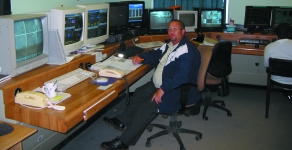
Finsch diamond mine in the Northern Cape is one of six operations managed by De Beers Consolidated Mines (DBCM). Established in 1961, the Finsch resource was first mined in an open pit fashion before having 'gone underground' in 1978. The 2005 production totalled 2,21m carats. Estimates suggest that reserves at Finsch are sufficient to maintain current mining rates until 2024.
The mine is currently in the process of transition from its historically open stoping mining method, applied in the upper levels of the underground mine, to a mass caving method, known as block caving, for its newly established ore block below.
Block 4 makes use of autonomous mining processes, the most significant at this stage being the recently launched and much lauded automated tramming system. Using the AutoMine system, six, 50-ton driverless Toro trucks haul Kimberlite ore from a tipping point to the underground crusher. Lasers and camera equipment on the haul trucks, as well as close circuit television (CCTV) along the tramming route allow operators in the Operation Centre to monitor the automated process on computer displays and CCTV monitors.

The challenge
With the expansion into Block 4 operation, it became clear that a purpose-built Operation Centre would have to be established to house the new equipment and create an environment conducive to efficient operation. Finsch completed the development of the Operation Centre in March 2005, and its modernity is in keeping with the latest technology being employed on the mine. The project team charged with the design of the centre took into account the ergonomic needs of the operators in positioning the PCs, monitors and workstations. In anticipation of international interest in the mine's leading edge technology, the centre accommodates visitors who can view operations unobtrusively from behind one-way glass.

The 659 m³ operation centre houses all the management systems in one area. The walls are plastered with Perlite to facilitate temperature control at between 16 and 22°C. Only fibre is used for data connections into the new centre and all cabling is stored under false flooring.
Data connections between the Operation Centre, other areas on the mine and level 62 (620 m underground) is achieved using 'blown fibre', an ultra-lightweight single bundle of optic fibres that is passed through pre-installed tubes using only airflow. The benefit of using blown fibre is that expansion in fibre requirements can be done without any stoppage in shaft operation because the fibre route (tubes) is installed separately from the actual fibres. When the actual cable (tubes with fibre blown into them) is damaged or needs to be replaced due to natural degradation, it can be repaired at a fraction of the time and costs required to install a traditional fibre cable.

A 1 gigabit/second Ethernet backbone handles the vast flow of data. Inside the Operation Centre network distribution is by UTP cable that is certified for CAT-6 (10 000BaseT) ie, it can handle up to 10 gigabits/second for future expansion. Four 62-inch plasma screens give an overview of the production status and progress; two for the autonomous operation, and two for the other mine operations. A fifth screen is also installed in the production building to give realtime coverage of the autonomous operations underground.
The Finsch management team had several goals that influenced the mine's selection of a control system. The control system was required to improve and enhance:
* Personal safety.
* Process efficiency.
* Productivity.
* Product quality.
* Process availability.
* Throughput.
* Information availability.
* Product security.
* Plant maintainability.
* Reduction of environmental harm.
* Prevention of damage to equipment.
* Minimisation of working and capital cost.
In addition, Finsch also required the employed scada system should deliver:
* Very high availability.
* High level of support availability.
* High performance.
* High scalability on a single platform.
* High volume and capacity sequencing subsystem.
* High proliferation of process viewing of graphics screens by non-operator personnel.
* 'Superior' connectivity.
Selecting the scada system
The particular scada system has the following functions:
* Monitoring, process control and equipment operation.
* Displaying process performance (process visualisation or HMI).
* Storing data ie, archive historical process performance information (data acquisition).
* Automating control of processes/equipment (low and high level control).
* Diagnosing process/equipment faults (operators and maintenance personnel).
* Making information available to various 'higher-level' management information systems to facilitate planning, optimisation, scheduling and strategic decision making.
After a careful selection process, a select group of De Beers mines in South Africa, Namibia and Botswana chose Citect as their preferred scada system. Among other factors, CitectSCADA was selected for its redundancy and system stability. The particular configuration employs dual redundant CitectSCADA server pairs. For the rock breaking, ore management, access control, production control, dispatch and CCTV, CitectSCADA is used throughout to deliver a total low-risk solution that eliminates downtime, lowers life-cycle costs and presents realtime information.
The Finsch mine wanted to develop a more intuitive operator interface with simplified configuration for easier maintenance and operation. The CitectSCADA system's easy configuration tools and user-friendly screens enabled the De Beers Finsch mine to implement the system without significant delays.
In planning the centre, one of the major identified risks of the project was the possibility of production downtime. Fortunately, the shift from the 'old' control centre to the new Operation Centre was a success. The CitectSCADA system was easily transferred to the new site without causing any downtime.
New control room advantages:
* Finsch created the Operation Centre to fit in with its existing technology.
* Finsch designed the Operation Centre to cater to all the current and future business requirements. Ample room was created for future expansion and extensions to the Finsch Mine.
* The Operation Centre meets all user requirements.
* The one-way glass allows visitors to view operations without disturbing operations.
* All supervisors and support personnel will be close by with a view on the Operation Centre.
* The Operation Centre also made room for the IT equipment room.
* Leisure room incorporated in the Operation Centre.
* Operation Centre can be constructed while existing Central Control Room is operational.
* Existing Central Control Room can be converted to much needed offices.

© Technews Publishing (Pty) Ltd | All Rights Reserved